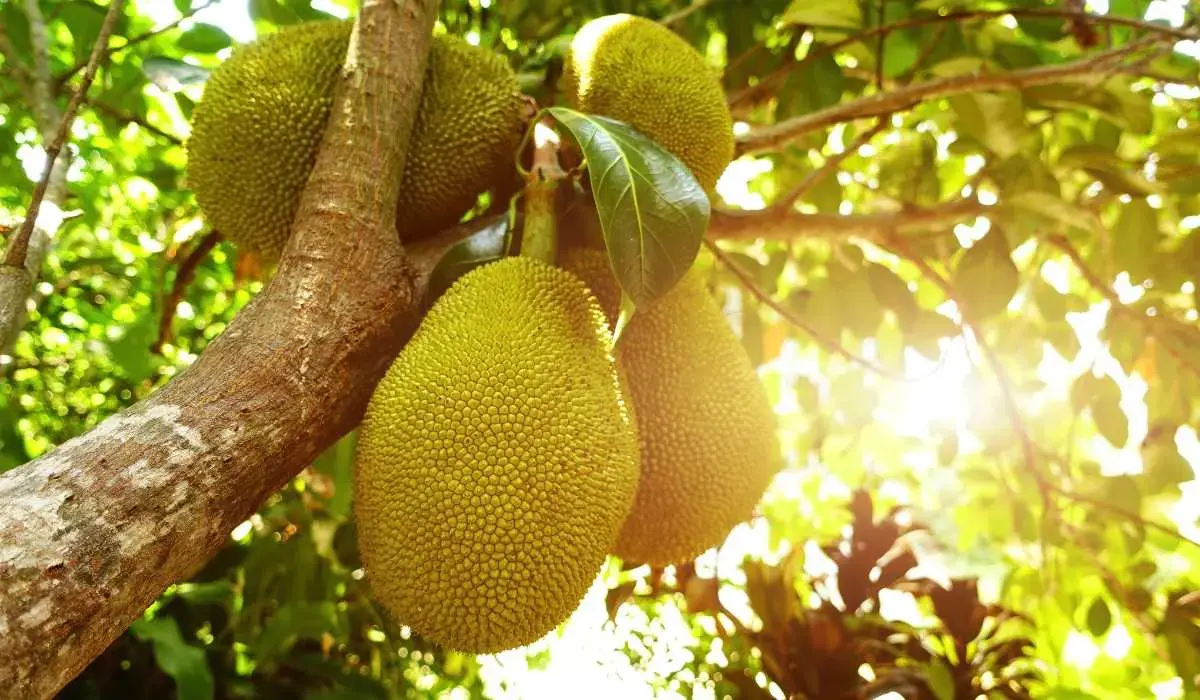
Appearance:
Size: Extremely large, ranging from 10 kg to often 25-30 kg (and sometimes even up to 50 kg or more!).
Shape: Typically oval or oblong, often irregularly shaped.
Skin (Exocarp): The skin is thick, rough, and covered with numerous small, conical or blunt projections (spines or tubercles) that become softer and less sharp as the fruit ripens. The color is typically green when unripe, turning yellowish-brown or brownish-yellow with dark spots as it ripens.
Flesh (Arils): This is the edible part. When cut open, a ripe jackfruit reveals numerous bright yellow to golden-orange bulbs or pods (arils). Each aril surrounds a single, large, brown, edible seed. The arils are embedded in a white, fibrous, sticky central core and surrounded by white, stringy, fibrous material that is generally not eaten.
Latex: Both the fruit and the tree produce a very sticky, white latex (sap) when cut, which is a significant consideration when handling it.
Flavor Profile & Aroma:
Unripe (Green) Jackfruit (as a Vegetable):
Taste: Very mild, neutral, and meaty, making it excellent at absorbing flavors from spices and sauces. It's often compared to the texture of pulled pork or chicken, making it a popular meat substitute in vegetarian and vegan cuisine.
Aroma: Very subtle or earthy.
Ripe Jackfruit (as a Fruit):
Taste: Intensely sweet and highly aromatic. The flavor is complex, often described as a blend of pineapple, mango, banana, and sometimes hints of bubblegum or Juicy Fruit gum. It's a distinct tropical sweetness.
Aroma: A very strong, sweet, and unique tropical aroma that can be quite pungent and pervasive, especially when fully ripe. Some find the smell overpowering, while others find it highly appealing.
Texture:
Unripe (Green) Jackfruit: The flesh is firm, somewhat starchy, and fibrous, allowing it to hold its shape well during cooking. It's often boiled, steamed, or stir-fried.
Ripe Jackfruit: The arils are soft, fleshy, and slightly fibrous, with a juicy, somewhat chewy consistency. The level of chewiness can vary by variety; some are softer and more melting, while others are firmer.
Seeds:
The large seeds within the arils are also edible once cooked (boiled or roasted), having a mild, starchy, nutty flavor and a texture similar to chestnuts or potatoes.
Seasonality & Availability (in Kochi, Kerala):
Jackfruit is a major fruit in Kerala and is typically harvested during the monsoon season, from roughly March/April to July/August, with peak availability in May and June. It's abundant during this time.
Other Notable Characteristics & Uses:
Versatility: This is one of its most remarkable attributes.
Unripe (Vegetable): Used extensively in curries (chakka thoran, chakka puzhukku in Kerala), stir-fries, chips, cutlets, and as a meat substitute.
Ripe (Fruit): Eaten fresh, made into juices, jams, desserts (chakka varatti - jackfruit preserve, chakka ada - steamed rice dumplings with jackfruit in Kerala), ice cream, and dried snacks.
Seeds: Boiled, roasted, or ground into flour.
Nutritional Value: A good source of carbohydrates, dietary fiber, Vitamin C, potassium, and various B vitamins. The seeds are rich in protein.
Sustainability: Jackfruit trees are hardy, grow easily in tropical climates, and produce a massive amount of food per tree, making them an important and sustainable food source.
Handling: Due to the sticky latex, it's advisable to oil hands and knives when cutting jackfruit.
In summary, the jackfruit is an enormous and highly aromatic tropical fruit, particularly cherished in Kochi, Kerala. It boasts incredible versatility, offering a mild, meaty texture when unripe (used as a vegetable) and an intensely sweet, complex, and fragrant flavor with a soft, chewy texture when ripe (eaten as a fruit), making it a significant and beloved part of local cuisine.

